
CHEMISTRY 1
.pdf
72 CUTTING-EDGE TECHNOLOGY
Nanotechnology
Tof materials, devices, and functional systems by controlling matter at the nanoscale. These new, atomically precise structures, such as carbon nanotubes or minuscule instruments to examinehe term “nanotechnology” refers to the study, design, synthesis, manipulation, and application
the inside of the human body, promise a new technological revolution still difficult to imagine. Specialists in the field expect numerous industrial, scientific, and social breakthroughs. One day, there will be materials that are more resistant than steel yet lighter, cleaner, and more efficient. Among many possible applications that could appear are computers with significantly faster components and molecular sensors capable of detecting and destroying cancer cells in the brain. 
1 nanometer (nm)
is one-billionth of a meter, or one-millionth of a millimeter (0.04 inch). In other words, it is equivalent to dividing 1 inch
into 25 million equal parts.
SOME
COMPARISONS
Water molecule:
0.3 nm
Maximum |
|
|
|
|
|
Thickness of a |
|
|
|
|
|||||||
circumference of a virus |
|
|
|
|
|
DNA molecule: |
|
|
|
|
|||||||
|
|
|
|
|
l |
|
2.5 nm |
|
|
Virus: |
|||||||
|
|
|
|
|
|
|
|
||||||||||
|
|
|
|
|
|
|
|
|
|
|
|
|
|
||||
|
|
|
|
|
|
l |
|
|
|
|
|
|
20-250 nm |
||||
|
|
|
|
|
|
|
c |
|
|
|
|
|
|||||
|
|
|
|
|
|
|
e |
|
|
|
|
|
|
|
|
||
|
|
|
|
|
|
|
|
n |
|
|
|
|
|
|
|
|
|
|
|
|
|
|
|
|
|
a |
|
|
|
|
|
|
|
|
|
|
|
|
|
|
|
|
|
|
m |
|
|
|
|
|
|
|
|
|
|
|
|
|
|
|
|
|
u |
|
|
|
|
|
|
|
|
|
|
|
|
|
|
|
|
|
h |
|
|
|
|
|
|
|
|
|
|
|
|
|
|
|
|
|
l |
|
|
|
|
|
|
|
|
|
|
|
|
|
|
|
|
|
a |
|
|
|
|
|
Bacteria: |
||
|
|
|
|
|
|
|
|
|
i |
|
|
|
|
|
|||
|
|
|
|
|
|
|
|
|
c |
|
|
|
|
|
|
|
|
|
|
|
|
Circumference |
|
|
|
|
p |
|
|
|
|
|
1,000 nm |
||
|
|
|
|
|
|
|
|
y |
|
|
|
|
|
||||
|
|
|
|
of a bacterium |
|
|
|
|
t |
|
|
|
|
|
|||
|
|
|
|
|
|
|
|
a |
|
|
|
|
|
|
|
|
|
|
|
|
|
|
|
|
|
|
f |
|
|
|
|
|
|
|
|
|
|
|
|
|
|
|
|
|
o |
|
|
|
|
|
|
|
|
|
|
|
|
|
|
|
|
|
e |
|
|
|
|
|
|
|
|
|
|
|
|
|
|
|
|
|
c |
|
|
|
|
|
|
|
|
|
|
|
|
|
|
|
|
|
n |
|
|
|
|
|
|
|
|
|
|
|
|
|
|
|
|
|
e |
|
|
|
|
|
|
|
|
|
|
|
|
|
|
|
|
|
r |
|
|
|
|
|
|
|
|
|
|
|
|
|
|
|
|
e |
|
|
|
|
|
|
|
|
|
|
|
|
|
|
|
u |
m |
f |
|
|
|
|
|
Red blood cell: |
|||
Circumference of |
irc |
|
|
|
|
|
|
|
7,000 nm |
|
|
||||||
|
|
|
|
|
|
|
|
|
|
||||||||
C |
|
|
|
|
Typical |
|
|
|
|
||||||||
a red blood cell |
|
|
|
|
|
|
|
|
|
||||||||
|
|
|
|
|
human cell: |
|
|
|
|
||||||||
|
|
|
|
|
|
|
|
|
|
|
|
|
|
||||
|
|
|
|
|
Thickness |
20,000 nm |
|
|
|
|
|
|
|||||
|
|
|
|
|
|
|
|
|
|
|
|
|
|||||
|
|
|
|
|
of a hair: |
|
|
|
|
|
|
|
|
||||
|
|
|
|
|
80,000 nm |
|
|
|
|
|
|
|
|
||||
Challenges
One of the challenges researchers face is how to develop nanotubes of the longest possible length.
The longest nanotube to date measures 1.5 inches (4 cm).
The Crystalline
Structure
|
|
The structure formed by atoms |
|
|
once they align affects the |
|
properties of the material. One example |
|
r |
is pure carbon, which, according to its |
|
|
|
|
i |
structure, can become: |
|
a |
||
h |
|
|
a |
|
|
f |
|
|
o |
1 |
Diamond |
e |
||
n |
|
|
c |
|
Very hard, |
e |
|
|
r |
|
|
e |
|
transparent mineral |
f |
|
|
m |
|
|
u |
|
|
c |
|
|
r |
|
|
i |
|
Carbon |
C |
|
|
atoms
Electrical links
Infinite Applications
There exist a variety of applications for nanotechnology. The following examples are the most immediate, although most are experimental. The imagination is the only limit.
Information technology |
New materials |
Robotics |
Molecular nanoprocessors containing |
will be dozens to hundreds |
Microscopic robots |
chips with microscopic transistors |
of times more resistant than |
(nanobots) will, for example, |
will be at the heart of computers |
known materials but will |
be able to travel inside organs |
millions of times more powerful than |
also weigh much less. |
and blood vessels to perform |
those that exist today. |
|
diagnostic tests and repairs. |
Electrical |
Carbon |
atoms |
|
links |
|
2 |
Graphite |
3 |
Fullerenes |
4 |
Nanotubes |
|
Soft, scaly, |
A new material |
More resistant |
||||
|
|
|
||||
|
and greasy |
|
with unknown |
|
than steel and |
|
|
|
|
properties |
|
excellent |
|
|
|
|
|
|
electrical |
|
|
|
|
|
|
conductors |
|
|
|
|
|
|
Electrical |
|
|
|
|
|
|
links |
|
|
|
|
|
|
Carbon |
|
Carbon |
|
Electrical |
|
|
atoms |
|
|
|
|
|
|||
atoms |
|
links |
|
|
|
TECHNOLOGY 73
|
Nanotubes |
||
|
|
are currently the stars of the |
|
|
|
field of nanotechnology. A |
|
|
nanotube is simply an atom layer |
||
|
folded into a tubelike shape one or |
||
|
a few nanometers in diameter. |
||
|
Nanotubes were discovered in |
||
|
1991 and have several surprising |
||
|
features, such as the ability to give |
||
|
them metallic or semiconductor |
||
|
properties of electrical |
||
|
conductivity, among other |
||
|
properties currently under study. |
||
|
|
Size |
|
|
|
0.6 to 1.8 nanometers |
|
|
|
in diameter |
|
|
PHYSICAL PROPERTIES |
||
|
Single wall |
A comparison |
|
|
nanotube |
|
|
|
|
|
|
Density |
0.77 to 0.81 oz/cu in |
Aluminum has a density of |
|
|
(1.33–1.40 g/cu cm) |
1.6 oz/cu in (2.7 g/cu cm) |
|
Resistance |
6.5 million pounds per |
Very tough steel alloys |
|
to tension |
square inch (45 billion |
break at around 290,000 |
|
|
pascal) |
pounds per square inch (2 |
|
|
|
billion pascal). |
|
Elasticity |
They can bend sharply and |
Metals and carbon fibers |
|
|
go back to their original |
break when subjected to |
|
|
shape without any damage. |
similar tests. |
|
Electric current capacity
Field emission
Estimated at 6.5 billion amperes per square inch (1 billion/sq cm).
Can activate phosphates with 1 to 3 volts if the electrodes are spaced out at 0.00004 inch (1  m).
m).
Copper wires melt at approximately 6.5 million amperes per square inch (1 million/sq cm).
Tips of molybdenum require fields of 15 to 30 volts per foot (50–100 V/m) and have very short life spans.
Heat transmission
Thermal stability
It is predicted to be as high as 3,300 watts per foot per degree Fahrenheit (6,000 W/m/K) at room temperature.
Stable even at 5,100° F (2,800° C) in a vacuum environment and at 1,390° F (750° C) in the air.
An almost pure diamond transmits 1,800 watts per foot per degree Fahrenheit (3,320 W/m/K).
The electrical wires inside microchips melt at between 1,100° F (600° C) and 1,800° F (1,000° C).
Cosmetics |
Transmission of |
Medicine |
Clothing |
Solar energy |
Data storage |
New smart |
electrical energy |
New medicines. |
Highly resistant, |
Huge improvements in |
There already exists a |
creams, |
Superconducting materials |
Molecular and genetic |
intelligent fabrics |
maximizing this clean |
memory card that |
particularly |
that do not suffer a loss of |
repairs. Microscopic, |
that do not get dirty |
and inexhaustible |
measures just 0.005 |
highly efficient |
energy during transportation |
protein-building |
or that can repel |
energy source |
square inch (3 sq mm) |
sunblocks |
at room temperature |
machines, among others. |
viruses and bacteria |
|
and has a capacity of |
|
|
|
|
|
100 gigabytes. |
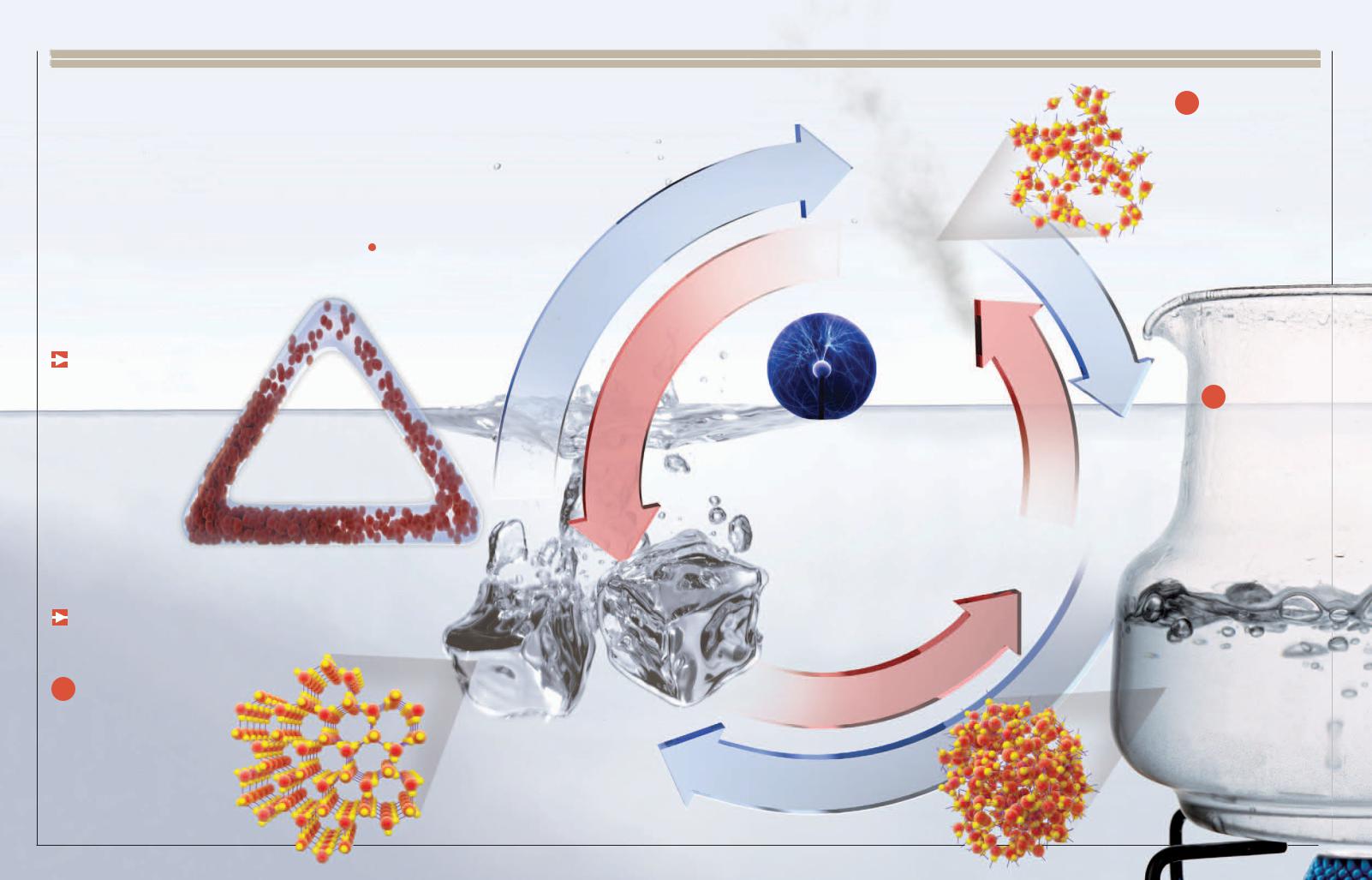
10 ORIGIN AND SOURCES
Matter
he dictionary says that matter is everything that takes up space. In other words, whatever makes |
||||||||||||
up a substance in the physical universe—the Earth, the seas, the Sun, the stars—is matter. |
|
|
|
|||||||||
TEverything that humans see, touch, or feel is matter. Matter can be hard as steel, adaptable as |
|
|||||||||||
water, and shapeless as the oxygen in the air. The study of matter has permitted the fabrication |
|
|
|
|||||||||
of tools, construction of cities, and even flights into space. Regardless of what is currently |
|
|
|
|
|
|
|
|
||||
known about it, the more scientists look into matter, the more complexity they find. For |
|
|
|
|
|
|
|
|
|
|||
example, it is now known that not even the hardest diamond is really solid, because the |
|
|
|
|
|
|
|
|
|
|||
atom—the heart of matter—is almost all empty space. |
|
|
|
|
|
|
|
N |
||||
|
|
|
|
|
|
|
|
|
|
|
||
|
|
|
|
|
|
|
|
|
|
|
O |
|
|
|
|
|
|
|
|
|
|
|
|
|
|
|
|
|
|
|
|
|
|
|
|
T |
I |
|
|
|
|
|
|
|
|
|
|
A |
|
|
|
|
|
Gas |
|
|
|
|
M |
|
|
|
||
What Is Matter |
|
|
|
L |
I |
|
|
|
|
|||
|
|
|
|
|
|
|
|
|
|
|||
Made of? |
|
|
|
U |
B |
|
|
|
|
|
|
|
|
|
|
|
|
|
|
|
|
|
|||
Matter is made of small particles called atoms. |
|
S |
|
|
|
|
|
|
|
|||
|
|
|
|
|
|
|
|
|
||||
|
|
|
|
|
|
|
|
|
|
|||
The atoms group themselves and form |
|
|
|
|
|
|
|
|
|
|
||
|
|
|
|
|
|
|
|
|
|
|
||
molecules, which are arranged into the various |
|
|
|
|
|
|
|
|
|
|
N |
|
forms of matter. In our daily lives, the most |
|
|
|
|
|
|
|
|
|
|
O |
|
commonly recognized states in which matter |
|
|
|
|
|
|
|
|
|
|||
exists are solid, liquid, and gas. In solid state, |
|
|
|
|
|
|
|
|
|
I |
|
|
bodies have an almost invariable volume |
|
|
|
|
|
|
|
|
|
|
|
|
|
|
|
|
|
|
|
|
|
|
T |
|
|
because their particles (atoms, ions, or |
|
|
|
|
|
|
|
|
|
|
|
|
|
|
|
|
|
|
|
|
|
|
I |
|
|
molecules) are in such close contact that |
|
|
|
|
|
|
|
|
|
|
|
|
|
|
|
|
|
|
|
|
|
|
S |
|
|
they can get no closer. When the |
|
|
|
|
|
|
|
|
|
|
|
|
temperature is high enough (melting), |
|
|
|
|
|
|
|
|
|
|
O |
|
particles lose their fixed positions |
|
|
|
|
|
|
|
|
|
|
|
|
|
|
|
|
|
|
|
|
|
P |
|
||
and, although they are still very |
|
|
|
|
|
|
|
|
|
|
||
close, the crystalline structures |
|
|
|
|
|
|
|
|
|
E |
|
|
exclusive to solids disappear in |
|
|
|
|
|
|
|
|
|
D |
|
|
changing to the liquid state. |
|
|
|
|
|
|
|
|
|
|
||
|
|
|
|
|
|
|
|
|
|
|
|
|
Above the boiling point, the |
Solid |
Liquid |
|
|
|
|
|
|
|
|
|
|
particles lose contact with |
|
|
|
|
|
|
|
|
|
|||
each other and move freely |
|
|
|
|
|
|
|
|
|
|
|
|
(gaseous state). |
|
|
|
|
|
|
|
|
|
|
|
|
From the Solid State to the Gaseous |
|
|
|
|
|
|
|
|
|
|||
Ice and steam are the same substance as liquid |
have the same shape and the same atoms in the three |
|
|
|
|
|
|
|
|
|
||
water. The difference lies in the strength with |
states. Water can change directly from ice to a |
|
|
|
|
|
|
|
|
|
||
which their molecules attract each other and the way |
gaseous state, but the process, called sublimation, |
|
|
|
|
|
|
|
|
|
||
in which they group themselves. Water molecules |
occurs slowly at normal air pressure. |
|
|
|
|
|
|
|
|
|
||
A
Solid State
As a general rule, in solids the particles (atoms or molecules) are closer together than liquids. That is why the density of a solid substance is greater than in the liquid state. However, water is an exception. In other words, when water freezes, it expands and becomes lighter. Ice floats on water because of this process. When the temperature of a piece of ice increases, the molecules increase their vibration and their separation.
JOINED |
32º F |
MOLECULES |
|
|
(0º C) |
|
Freezing point. |
|
The temperature at which water |
|
passes from the liquid to solid state. |
Plasma State
Plasma is sometimes called “the fourth state of matter.” It is a gas in which the atoms have lost their electrons and therefore have an electrical charge. The electrically charged atoms are called ions. Plasmas conduct electricity and are influenced by magnetic fields. For example, in a fluorescent bulb, mercury vapor becomes a plasma that produces ultraviolet radiation and causes phosphors to fluoresce. The Sun and stars are also in this state. They are not solids.
SEPARATED
MOLECULES
C |
|
O |
|
N |
|
D |
|
E |
|
|
N |
|
S |
|
A |
|
T |
|
I |
E |
O |
|
|
V |
N |
A |
|
P |
|
O |
|
R |
|
A |
|
T |
|
I |
|
O |
|
N |
|
ENERGY AND MOVEMENT 11
C
Gaseous State
At various temperatures, molecules escape the surface of liquid water to form gas or steam. The change from gas to liquid state is called condensation, and the change from liquid to solid state is called solidification, or freezing. In other instances, there can be a direct change from solid to gas (sublimation) and from gas to solid (condensation).
B
Liquid State
As in all liquids, water molecules tend to form groups. They can move over one another, allowing water to flow with ease. The variable form of liquids (which adjust to the containers that house them) results from the fact that, above the melting point, liquid particles do not stay in the fixed positions of a solid and instead move in a disordered fashion.
|
|
|
|
G |
|
|
|
|
N |
|
|
|
I |
|
|
|
T |
|
|
|
L |
|
|
|
E |
|
|
|
|
M |
|
|
|
|
F RE EZING
212º F
(100º C)
Boiling point. The temperature at which water turns into vapor.
LOOSELY JOINED
MOLECULES
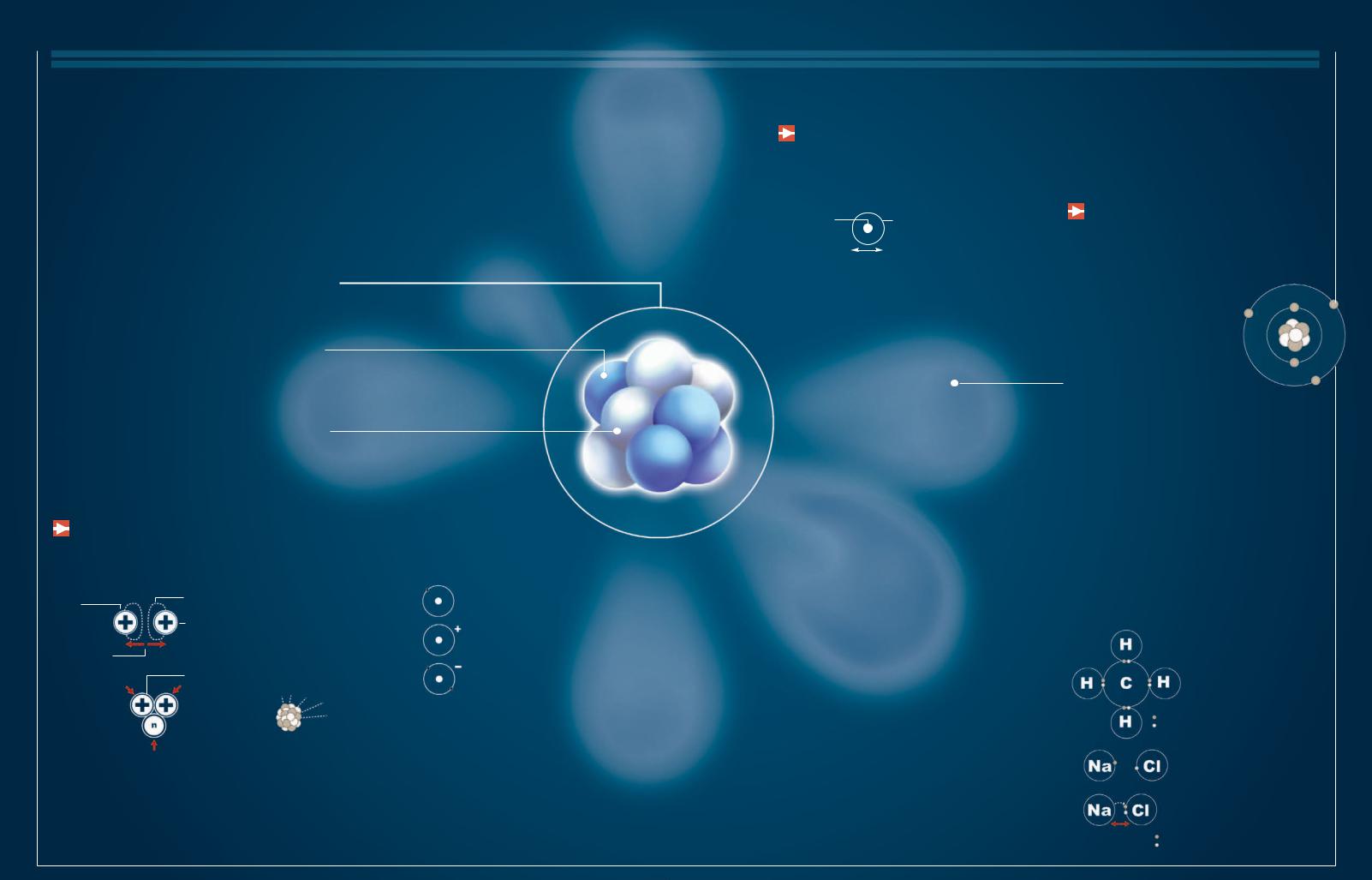
12 ORIGIN AND SOURCES
The Atom
Iretains its identity and properties; it cannot be divided any further by chemical processes (it can, however, be divided by physical processes). All matter in then physics and chemistry, an atom is the smallest unit of a chemical element that
universe is made up of atoms. This concept originated in ancient Greece, but the existence of the atom was not demonstrated until the 19th century. The development of nuclear physics in the 20th century led to the discovery that the atom can
be subdivided into various types of smaller particles. 
Nucleus
How It Is Held Together
Because protons have positive charges, they repel each other. However, the atomic nucleus
remains intact because of another force of greater magnitude, though of shorter range, known as the strong nuclear interaction.
Protons |
The electric field |
is long range. |
|
|
Short-range |
The two positive |
nuclear force |
|
|
electric fields repel |
|
each other. |
|
|
Neutrons add |
|
nuclear force, |
If the protons get |
without an |
close enough, the |
electric charge, |
nuclear force |
reinforcing the |
attracts them and |
bond. |
keeps them |
|
joined. |
|
determines the physical properties that distinguish one element from another. It contains most of the atom's mass (atomic weight).
PROTONS
ELECTRICAL CHARGE: POSITIVE ATOMIC WEIGHT: 1
The quantity of protons determines the chemical element to which the atom belongs. For example, if three protons are removed from a lead atom, a gold atom remains.
NEUTRONS
ELECTRICAL CHARGE: NEUTRAL
ATOMIC WEIGHT: 1
Helps hold the nucleus together.
ISOTOPES |
IONS |
The nucleus of a given element can have a variable number of neutrons without changing its fundamental nature. These variations of the same element have slightly different behaviors and are known as isotopes.
RADIOACTIVITY
If the number of electrons is equal to the number of protons, the atom is electrically neutral.
If the atom loses an electron, it transforms into a positive ion, or cation.
Certain unstable isotopes decay over
time, emitting particles and radiation. If it gains an extra one, it becomes a negative ion, or
anion.
Particles
History of the |
500 BC |
1808 |
1869 |
ANCIENT GREECE |
JOHN DALTON |
DMITRY MENDELEYEV |
|
Atomic Theory |
Democritus and Leucippus |
states that atoms of a |
organizes the elements |
assert that matter is |
same element measure |
according to their |
|
|
composed of tiny, |
and weigh the same |
atomic weight in the so- |
|
indivisible particles that |
but not those of a |
called periodic table of |
|
are in constant motion. |
different element. |
elements. |
Invisible to the Microscope
The atoms cannot be seen through a microscope (either optical or electronic). Computational advancements have allowed us to
obtain images of the position that atoms occupy in a substance, but the structure of each individual atom has not been imaged.
ATOMIC STRUCTURE
Nucleus: The |
Electron cloud: |
densest part of |
Lightest region |
the atom |
that surrounds |
|
the nucleus |
|
Diameter 0.0000001 mm |
1911 |
1920 |
ERNEST RUTHERFORD |
QUANTUM MECHANICS |
develops the first |
sets the foundation for the |
coherent model that |
discovery of atoms in the |
explains the atomic |
20th century. In 1932, |
structure. It was improved |
neutrons were discovered, |
in 1913 by Niels Bohr. |
completing the model. |
ENERGY AND MOVEMENT 13
10 trillion
THE NUMBER OF ATOMS THAT CAN FIT ON THE SURFACE OF A PINHEAD
Electron Cloud
The electrons are found in the electron cloud. An electron has a negative electrical charge and an atomic weight of 0.0005434
amu. The electrons determine the chemical and electrical properties of elements, and they are involved in bonding with other atoms. Within the electron cloud, the electrons are distributed in orbits, or orbitals.
Electron Orbitals
RUTHERFORD-BOHR MODEL (PLANETARY MODEL)
This model, which is obsolete, depicted electrons as planets that revolve around the nucleus. However, it is the model that persists in popular perception.
VALENCE SHELL MODEL (QUANTUM MODEL)
The electrons are not in a fixed orbit but in regions of greater or lesser probability, and they can move in any direction within the region.
Quantum Leap
Niels Bohr discovered that electrons orbit the atom with discrete levels or quanta of energy—that is, not all orbitals are permitted but only a finite number. The electrons jump from one level to another in quantum leaps. If a jump is from a higher energy level to a lower one, a photon is released (emits light). If the jump is reversed, a photon is captured (absorbs light).
Molecules
are typically structures with two or more atoms joined by bonds that can be covalent, or ionic.
H
HC
H
Na
Na
Electronic bond
COVALENT BOND
The bonding electrons are shared by both atoms.
H
Carbon electron
Hydrogen electron
IONIC BOND
An electron abandons the least electronegative atom to become part of the electron cloud of the more electronegative one.
Sodium electron
Chlorine electron
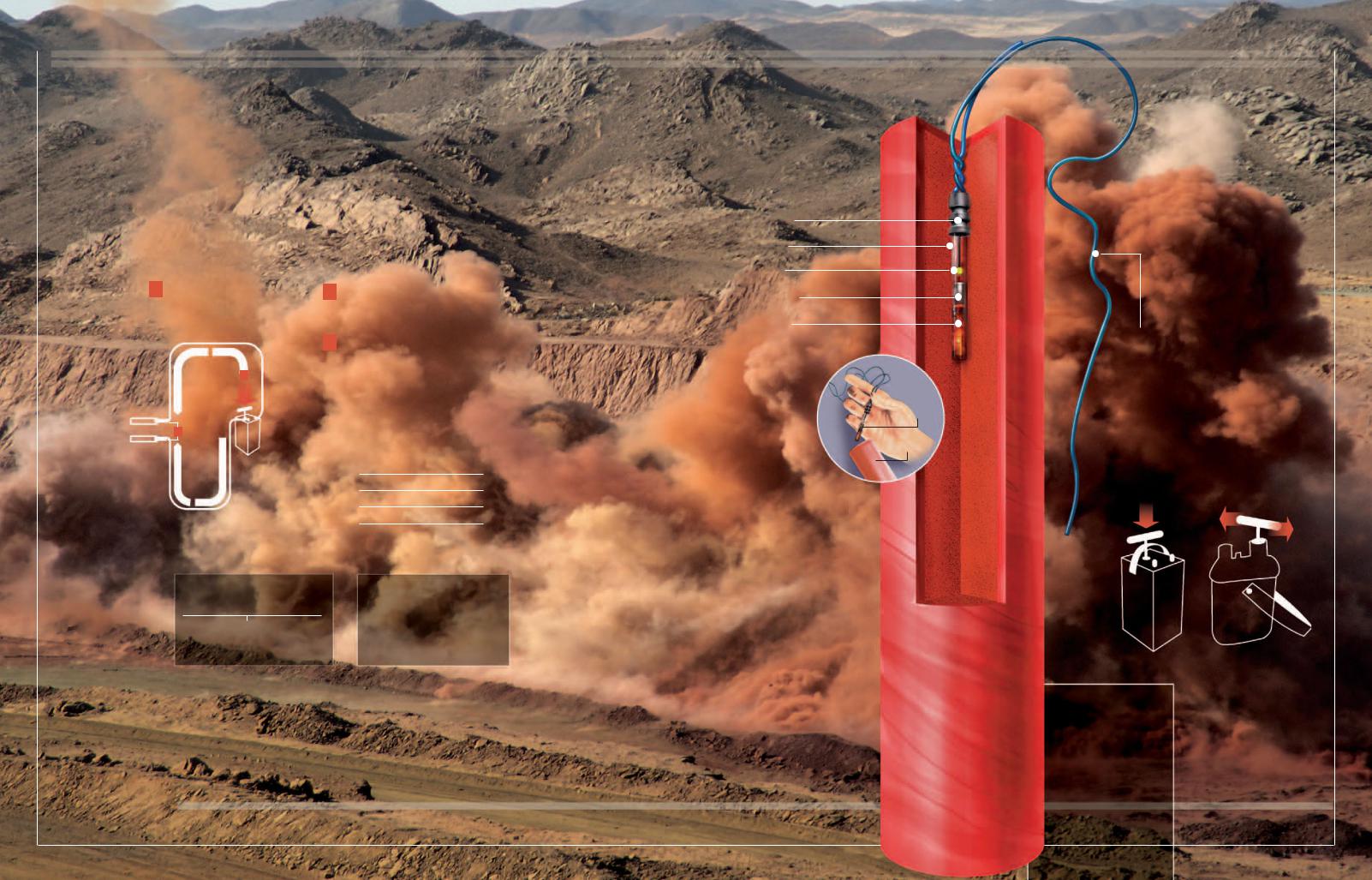
26 MANIFESTATIONS OF ENERGY
Dynamite
Tby Alfred Nobel in 1867, and it quickly replaced nitroglycerin, which was unstable and dangerous. Dynamite was the most commonly used explosive until 1950. It is so stable that new sticks inhe term “dynamite” comes from the Greek word dynamis, which means “force.” It was invented
good condition generally do not explode even when exposed to fire; a detonator is necessary to make them explode. The fortune that Alfred Nobel earned with his invention was used for the creation of the award that carries his name. 
How It Works
1The detonators are connected to the sticks of dynamite. By means of a safety fuse, the detonators are attached to the central detonator.
Safety
fuse
2
Dynamite |
1 Detonators |
Exploder
What It Is Made of
2When the detonator is activated, a small explosion is created, causing the subsequent explosion of the dynamite.
3EXPLOSION
Dynamite explodes when the detonators are activated.
WHAT IT WAS USED FOR
Blasting in mines and quarries
Tunnel construction
Demolition
Military use
3 PARTS NITROGLYCERIN |
|
1 PART DIATOMACEOUS EARTH |
Glycerin + sulfuric acid + nitric acid |
+ |
(kieselguhr) |
|
||
NITROGLYCERIN |
Very porous and absorbent material. When |
|
|
mixed with nitroglycerin, it produces a |
|
Thick, oily, colorless or yellow liquid. Very |
|
malleable paste, reducing nitroglycerin's |
|
notorious volatility. |
|
volatile, sensitive to shock, friction, and heat. |
|
|
History of |
GUNPOWDER |
NITROGLYCERIN |
NITROCELLULOSE |
|
|||
Explosives |
Invented in China |
Ascanio Sobrero |
Christian Schönbein |
Made of sulfur, carbon, and |
Made with glycerol, sulfuric acid, and |
Cellulose + nitric acid + sulfuric acid. It is |
|
|
potassium nitrate. The first explosive |
nitric acid. It is a very powerful explosive |
known as smokeless gunpowder because it |
|
in history, it was at first used only to |
that is liquid and colorless. Unstable and |
has great explosive power, but, unlike |
|
shoot fireworks. |
very volatile, it explodes easily. |
gunpowder, it does not give off black smoke. |
DETONATOR
The detonator, or blasting cap, is activated by lighting a fuse. It was invented by Nobel.
Crimps
Shell
Fuse
Ignition charge
Primer charge
Detonator
Cartridge
EXTERNAL CARTRIDGE 

protects and contains the interior (dynamite). It minimizes the leaking of nitroglycerin and protects it from moisture and water.
TNT (TRINITROTOLUENE)
Joseph Wilbrand
Made of carbon, hydrogen, oxygen, and nitrogen. Potent explosive. Solid, colorless or pale yellow, and odorless. It is exploded with a detonator.
ENERGY AND MOVEMENT 27
SAFETY FUSE
Made up of layers of impermeable plastic that protect the gunpowder core
ELECTRIC DETONATORS
supply direct current to the detonators, permitting their activation from a great distance.
RACK |
TWIST |
Pressure |
Turn |
DYNAMITE |
MODERN EXPLOSIVES |
Alfred Nobel |
Ammonium nitrate is the basis for |
patented dynamite in 1867. |
modern explosives. An example is |
He operated several |
ANFO, a mixture of ammonium |
factories where the |
nitrate and fuel, which is currently |
explosive was produced. |
the most commonly used explosive. |
10th Century AD 1846 |
1846 |
1863 |
1867 |
1955 |
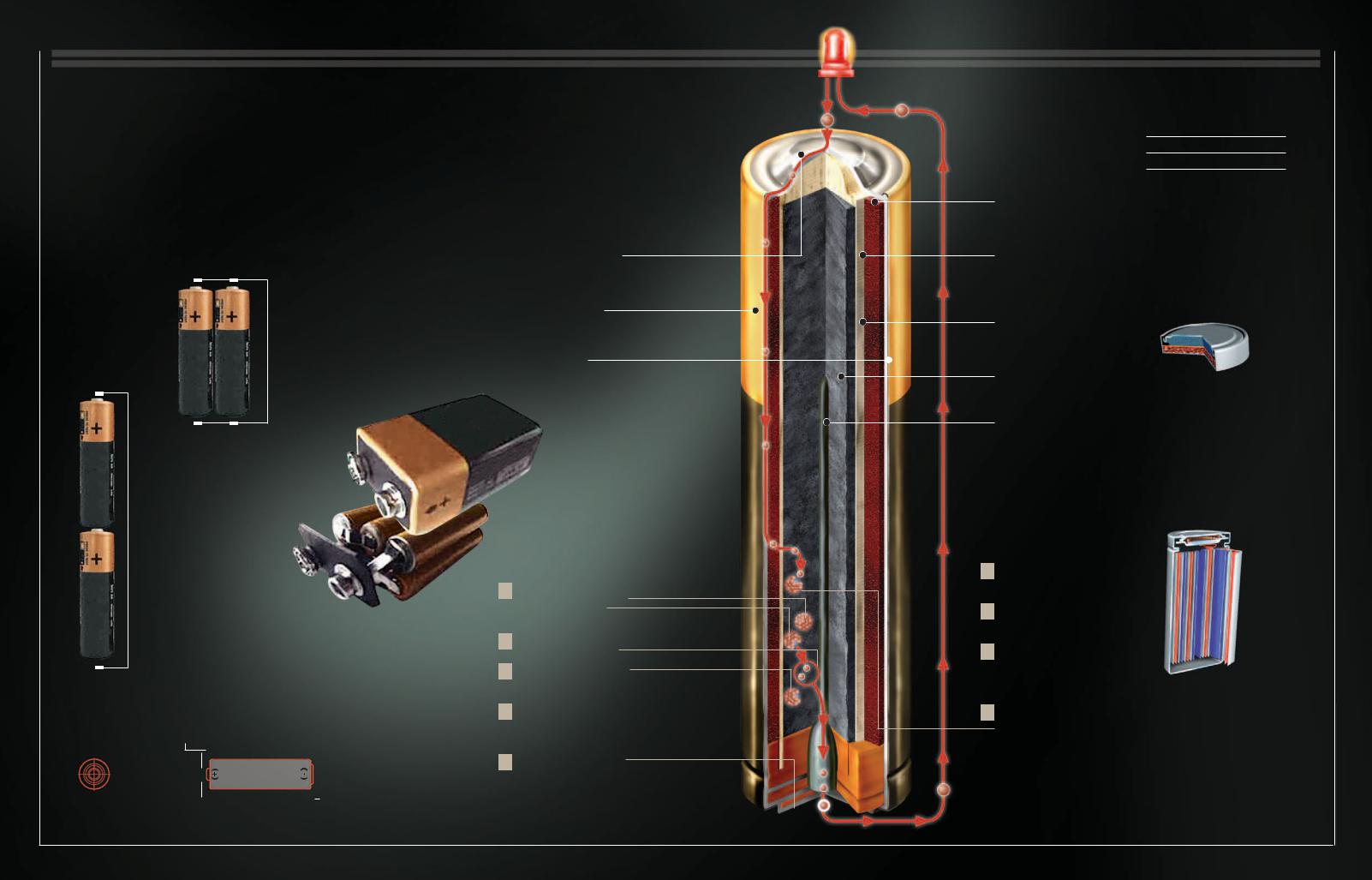
28 MANIFESTATIONS OF ENERGY
The Battery
Gof its components, and consequently a battery becomes discharged after a certain amount of use. The battery can produce an electric current between its two terminals,enerates electrical power by means of a chemical process that alters the characteristics
which are also known as poles or electrodes. The battery derives its name from the early practice of lining cells together horizontally, like batteries of troops. 
Adding Together Energy
IN PARALLEL
The positive terminals are first connected to each other, followed by the negative ones.
The voltage remains the same, but the batteries last longer.
9 V BATTERY
Formed by six 1.5 V cells in series.
POSITIVE TERMINAL has the shape of a circular button.
PLASTIC LINING serves as insulation.
NICKEL-PLATED STEEL CASE
contains the active ingredients and is the positive collector.
1.5 V x 6 = 9 V
1.5 V
+IN SERIES
The negative terminal of one connects to the negative terminal of the next one.
The voltage of the 1.5 V batteries is added.
The power remains the same.
Two 1.5 V batteries produce 3 V.
AA Model
Standard measurements 1.00
(mm) |
minimum |
|
|
|
|
50.50 |
|
|
|
||||
|
|
|
|||||||||||
|
|
|
|
|
|
|
49.20 |
|
|
|
|||
|
|
|
|
|
|
|
|
|
|
|
|
||
|
|
|
|
|
|
|
|
|
|
|
|
|
|
|
|
|
|
|
|
|
|
|
|
|
|
|
|
|
|
14.50 |
|
|
|
|
|
|
|
|
|
|
|
|
|
|
|
|
|
|
|
|
|
|
|
|
|
|
|
13.50 |
|
|
|
|
|
|
|
|
|
|
|
|
|
|
|
|
|
|
|
|
|
|
|
|
|
|
|
|
|
|
|
|
|
|
|
|
|
|
|
|
|
5.50 |
|
|
|
|
|
|
48.80 |
|
0. 10 |
||
|
|
Maximum |
|
|
|
|
Minimum |
||||||
|
|
|
|
|
|
|
|
|
46.50 |
|
|
||
OPERATION
NEGATIVE TERMINAL
produces the electrons that enter the circuit to make it work.
1When the battery is connected to an electrical circuit, the zinc
in the anode oxidizes.
2For each zinc atom that oxidizes, two electrons are released.
3A residue of very unstable zinc ions is left behind.
4The anode collector conducts the electrons to the negative terminal of the cell.
5From the negative terminal, the electrons enter the electrical circuit.
CATHODE
Made of manganese dioxide and graphite, it receives electrons from an external circuit.
ELECTROLYTE
A solution of potassium hydroxide that transports the ionic current inside the cell
SEPARATOR
Made of porous, nonwoven fabric. It separates the electrodes and also contains the electrolyte.
ANODE
Zinc powder. It serves as the source of electrons.
ANODE COLLECTOR
Tin-covered metal. It conducts the electrons from the anode to the external circuit.
POSITIVE TERMINAL receives the electrons from the circuit to keep the tension high.
6Takes up the electrons and transfers them to the cathode.
7The electrons combine with the manganese dioxide to form negative ions.
8These ions combine with the water in the electrolyte. They separate into negative hydroxide ions and positive hydrogen ions.
9The negative hydroxide ions pass to the anode. They combine with the unstable zinc ions, generating zinc oxide and water.
When all the zinc has converted to oxide and water, the battery is discharged.
ENERGY AND MOVEMENT 29
ALKALINE BATTERY
VOLTAGE |
1.5 V |
DURATION IN WATT-HOURS |
2.5 |
IN AMPERE-HOURS |
2.8 |
Types
1.5 V
CLOCK
Frequently made of lithium, it is more expensive but takes up less space than alkaline batteries.
1.2 v
RECHARGEABLE
The most used are nickel metal hydride batteries. They have less voltage and a shorter life than alkaline batteries, but they can be recharged many times.
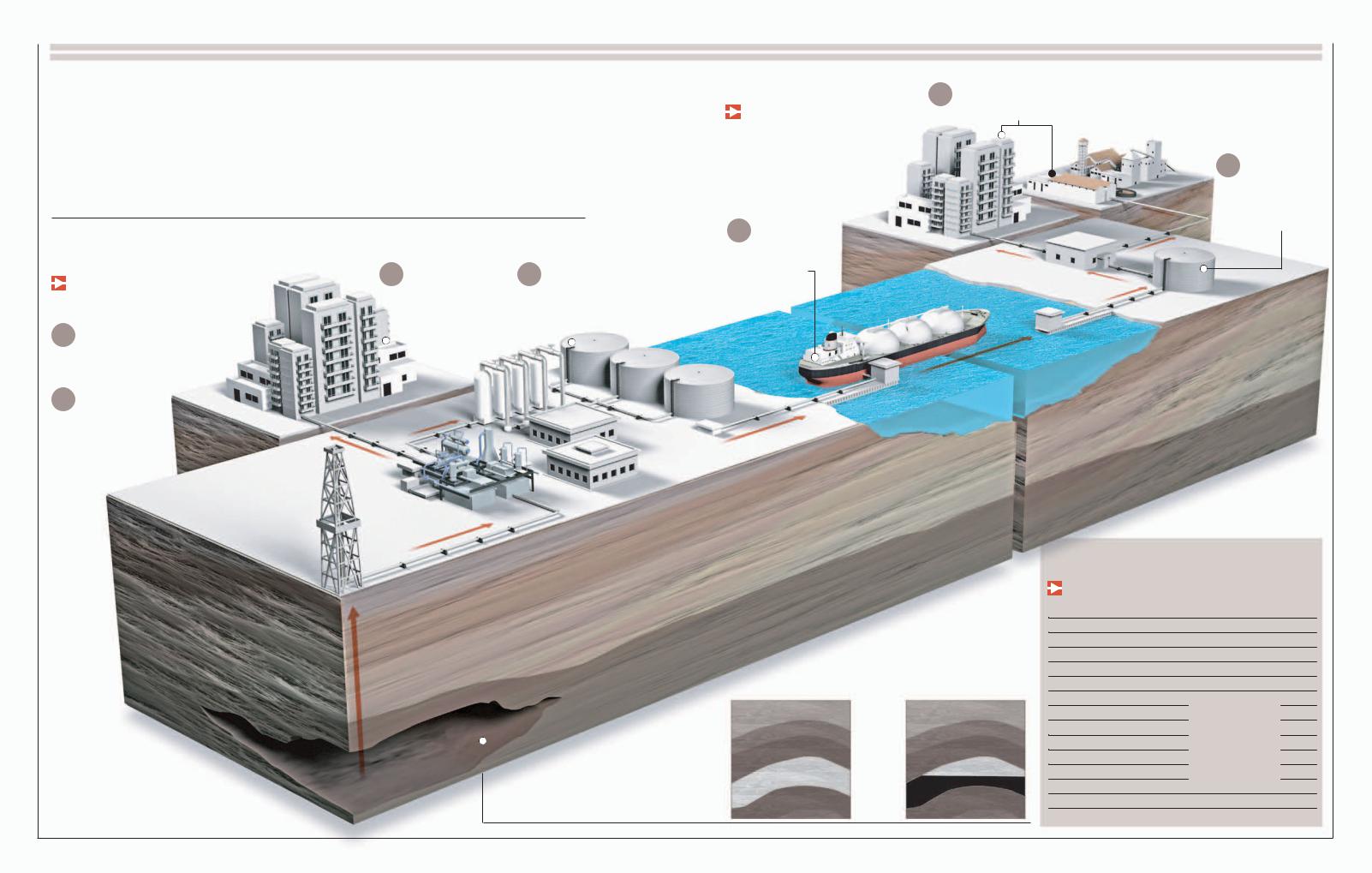
40 ENERGY RESOURCES
Natural Gas
A fter petroleum, natural gas slowly rose to a position of importance in the global balance of energy sources because of its availability and efficiency. It has a reputation of being the cleanest fossil fuel. Technological advances, especially in the discovery of deposits, have
produced an explosion in the reserve statistics in the last 15 years. These developments have been accompanied by an ever-increasing dependency on natural gas in different parts of the planet. 
Phantom Energy |
3 |
DISTRIBUTION |
4 |
LIQUEFACTION |
||||
|
|
|||||||
|
Natural gas is a colorless, odorless fluid that |
After being distilled and |
When it must be |
|||||
|
contains between 70 and 90 percent methane, the |
|
|
converted essentially into |
|
transported by sea or stored, |
||
component that makes it useful as a source of energy. |
|
|
methane, natural gas is |
|
the gas is compressed and |
|||
|
|
|
|
distributed for use |
|
cooled to -258° F (-161° C) |
||
2 |
REFINEMENT |
|
|
through gas pipelines. |
|
to liquefy it. |
||
|
|
|
|
|
|
|
||
|
|
|
|
|
|
|
||
The solid and wet components are |
|
|
|
|
|
|
|
|
|
|
|
|
|
|
|
||
|
separated. Then the byproducts, like |
|
|
|
|
|
|
|
|
propane and ethylene, are separated. |
|
|
|
|
|
|
|
1 |
EXTRACTION |
|
|
|
|
|
|
|
The gas is extracted |
|
|
|
|
|
|
|
|
from the deposit through a hole. When the gas is under pressure, it rises to the surface on its own. When it is not under pressure, it must be pumped.
LPG
Liquefied petroleum gas (LPG) is a byproduct of natural gas. It is bottled in cylinders and used by people who live in remote areas to operate, for instance, boilers and motors.
Deposit
Gas tends to be located inside porous rocks capped by impermeable rocks that are not necessarily associated with petroleum.
Lossless Trip
Among the many virtues of natural gas is the
efficiency with which it can be transported. From gas deposits, it can be sent thousands of miles by ship or through gas pipelines with minimal losses.
5 TRANSPORT
Large, double-hulled, pressurized ships transport the gas in a liquid state.
7DISTRIBUTION
The gas reaches residential and commercial consumers.
ENERGY AND MOVEMENT 41
1/600
The reduction in volume of natural gas when it is liquefied for storage or transport
6 GASIFICATION
After transport, the liquefied gas is returned to the gaseous state to be distributed through a network of gas mains.
Reserves
The largest reserves of natural gas in the world are found in Russia and the Middle East.
|
|
|
|
|
|
|
|
|
Country |
Trillion cubic feet |
% of Total |
|||||||||||||
|
|
|
|
|
|
|
|
|
Russia |
|
|
|
|
|
|
|
|
|
|
|
|
|
1,680 |
27.4 |
|
|
|
|
|
|
|
|
|
|
|
|
|
|
|
|
|
|
|
|
|
|
|||
|
|
|
|
|
|
|
|
|
|
|
|
|
|
|
|
|
|
|
|
|
|
|||
|
|
|
|
|
|
|
|
|
Iran |
|
|
|
|
|
|
|
|
|
|
|
|
|
15.9 |
|
|
|
|
|
|
|
|
|
|
|
|
|
|
|
|
|
|
|
|
|
971 |
|
|||
|
|
|
|
|
|
|
|
|
|
|
|
|
|
|
|
|
|
|
|
|
||||
|
|
|
|
|
|
|
|
|
Qatar |
|
|
|
|
|
|
|
|
|
|
911 |
|
14.9 |
||
|
|
|
|
|
|
|
|
|
|
|
|
|
|
|
|
|
|
|
|
|||||
|
|
|
|
|
|
|
|
|
Saudi Arabia |
|
|
|
|
|
|
|
|
|
241 |
|
|
|
|
3.9 |
Dry gas deposits |
Petroleum deposits |
|
|
|
|
|
|
|
|
|
|
|
|
|
||||||||||
United Arab Emirates |
|
|
|
|
|
|
|
|
214 |
|
|
|
|
3.5 |
||||||||||
|
|
|
|
|
|
|
|
|
|
|
|
|||||||||||||
|
|
|
|
|
|
|
|
|
|
|
|
|||||||||||||
|
|
|
|
|
|
|
|
|
United States |
|
|
|
|
|
|
|
204 |
6,124 |
3.3 |
|||||
|
|
|
|
|
|
|
|
|
|
|
|
|
|
|
|
|||||||||
|
|
|
|
|
|
|
|
|
Algeria |
|
|
|
|
|
|
|
2.6 |
|||||||
|
|
|
|
|
|
|
|
|
|
|
|
|
|
|
161 |
|||||||||
|
|
|
|
|
|
|
|
|
Nigeria |
|
|
|
|
|
|
185 |
|
|
|
|
3.0 |
|||
|
|
|
|
|
|
|
|
|
Venezuela |
|
|
|
|
|
|
|
|
|
2.5 |
|||||
|
|
|
|
|
|
|
|
|
|
|
|
|
|
151 |
trillion cubic feet is |
|||||||||
|
|
|
|
|
|
|
|
|
|
|
|
|
|
|||||||||||
|
|
|
|
|
|
|
|
|
|
|
|
|
|
|||||||||||
|
|
|
Impermeable |
|
|
Iraq |
|
|
|
|
112 |
the total of the |
1.8 |
|||||||||||
|
|
|
|
|
|
|
|
|
||||||||||||||||
|
Gas chamber |
|
rock |
|
|
Gas chamber |
Indonesia |
|
|
|
98 |
known reserves in |
1.6 |
|||||||||||
|
|
|
|
|
|
|
||||||||||||||||||
|
|
|
|
|
Petroleum |
|
|
|
the world. |
|||||||||||||||
|
|
|
|
|||||||||||||||||||||
|
|
|
|
|
|
|
|
Norway |
|
|
84 |
|
|
|
|
1.4 |
||||||||
|
|
|
|
|
|
|
|
|
|
|
|
|
|
|||||||||||
|
|
|
|
|
|
|
|
|
Malaysia |
|
75 |
|
|
1,037 |
|
1.2 |
||||||||
|
|
|
|
|
|
|
|
|
|
|
|
|
||||||||||||
|
|
|
|
|
|
|
|
|
Rest of the world |
|
|
|
|
|
|
|
|
|
|
|
|
16.9 |
||
|
|
|
|
|
|
|
|
|
|
|
|
|
|
|
|
|
|
|
|
|
|
|||
|
|
|
|
|
|
|
|
|
|
|
|
|
|
|
|
|
|
|
|
|
|
|
|
|
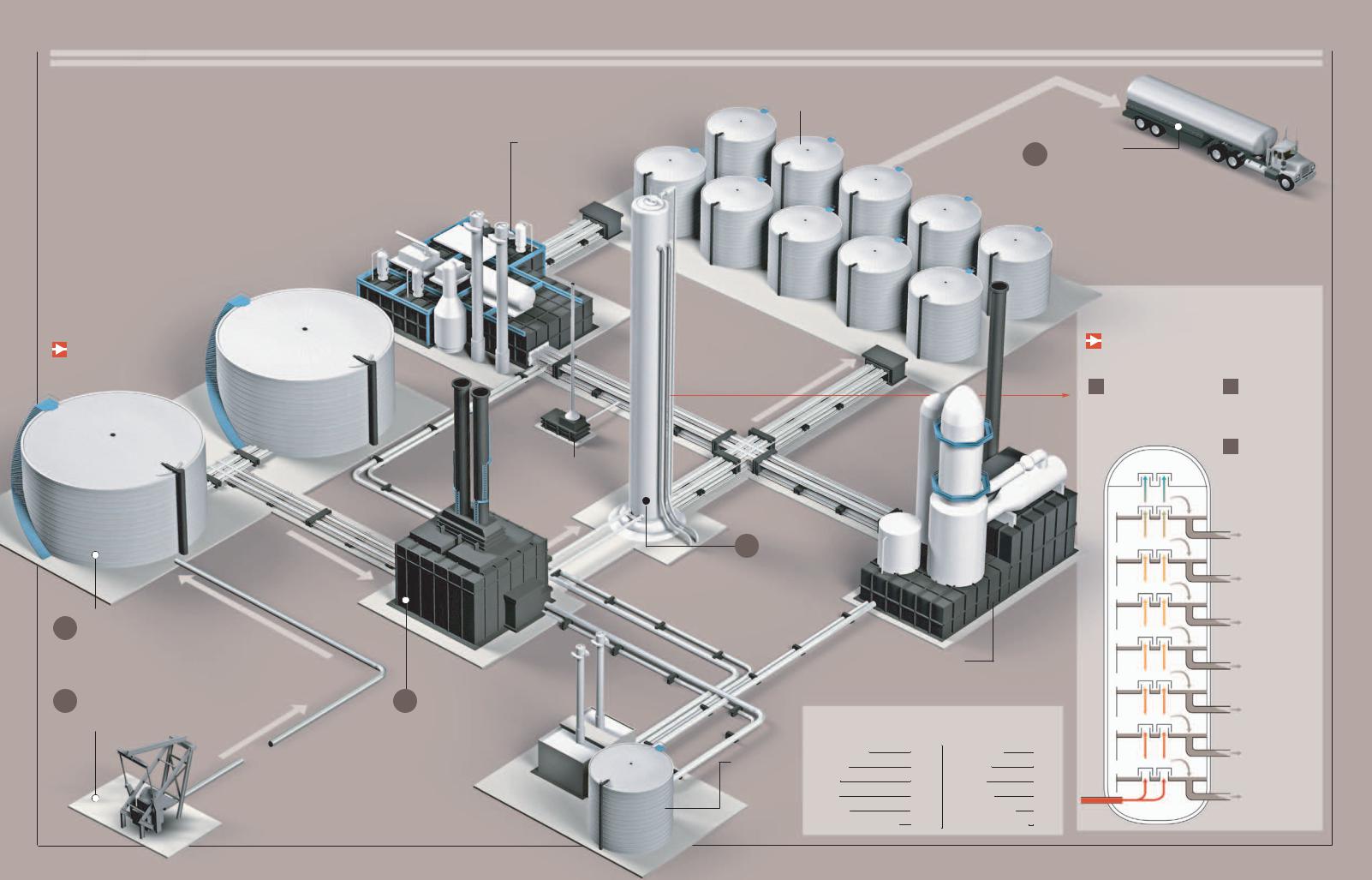
42 ENERGY RESOURCES
Petroleum
Pfrom ancient organic deposits that have been buried in the bowels of the Earth for hundreds of millions of years. Its pure state, called crudeetroleum is the main energy source in the developed world. It comes
oil, is a mix of different hydrocarbons of little use, and hence the oil must first be distilled to separate its components. This valuable resource, which pollutes the atmosphere when burned, is nonrenewable and available only in limited reserves;
these characteristics have driven researchers to look for alternative energy sources.
Contaminant-gas treatment units
From the Well to the Tank
After its extraction, crude oil is distilled and fractioned
into several products, among them gasoline.
Gas flare stack
2
1
CRUDE OIL STORAGE
The crude oil is stored and then transported to refineries through pipelines or by large tanker ships.
EXTRACTION
The oil is pumped from the deposit up to the storage tanks.
3 VAPORIZATION
The crude oil is heated in a boiler up to 752° F (400° C) or more. Once
vaporized, it is sent through the distilling tower.
2050
The year the world's oil reserves could run out if the current rate of consumption is maintained and no new discoveries are made.
ENERGY AND MOVEMENT 43
Storage tanks
5 TRANSPORT
Refined fuels are taken to their distribution terminals through different means of transport.
49 gallons (159 l)
Connecting pipes
4 DISTILLATION permits the separation of the crude oil into its diverse components, which are then
stored separately.
Catalytic separation unit
converts some distillation products into lighter, more valuable products through catalysts.
KNOWN CRUDE OIL RESERVES
In billions of barrels (year 2006)
|
1. |
Saudi Arabia |
264.3 |
7. |
Venezuela |
79.7 |
|
Residual |
2. |
Canada |
178.8 |
8. |
Russia |
60.0 |
|
treatment |
|||||||
3. |
Iran |
132.5 |
9. |
Libya |
39.1 |
||
system |
|||||||
|
4. Iraq |
115.0 |
10 |
Nigeria |
35.9 |
||
|
5. |
Kuwait |
101.5 |
11. |
United States |
21.4 |
|
|
6. |
United Arab Emirates |
97.8 |
|
Rest of the world |
166.6 |
|
The measure of a barrel of petroleum. Currently the global demand for petroleum is about 86 million barrels per day.
Distillation
The process through which oil is refined. It consists of applying heat to crude oil to separate its components,
which all have different boiling and condensation points.
1After being heated to 752° F (400° C), the oil enters as vapor into the lower reaches of the distillation tower.
Colder
Gasified |
Hotter |
crude oil |
|
2The vapor rises, crossing a series of perforated plates. As it rises, it cools.
3The different compounds condense at different temperatures and are collected in different plates.
Gases for bottling (propane and butane), petrochemical products
Gasoline
Kerosene
Diesel
Industrial fuels
Lubricants, polish, waxes
Asphalt,
waterproofing, other residues
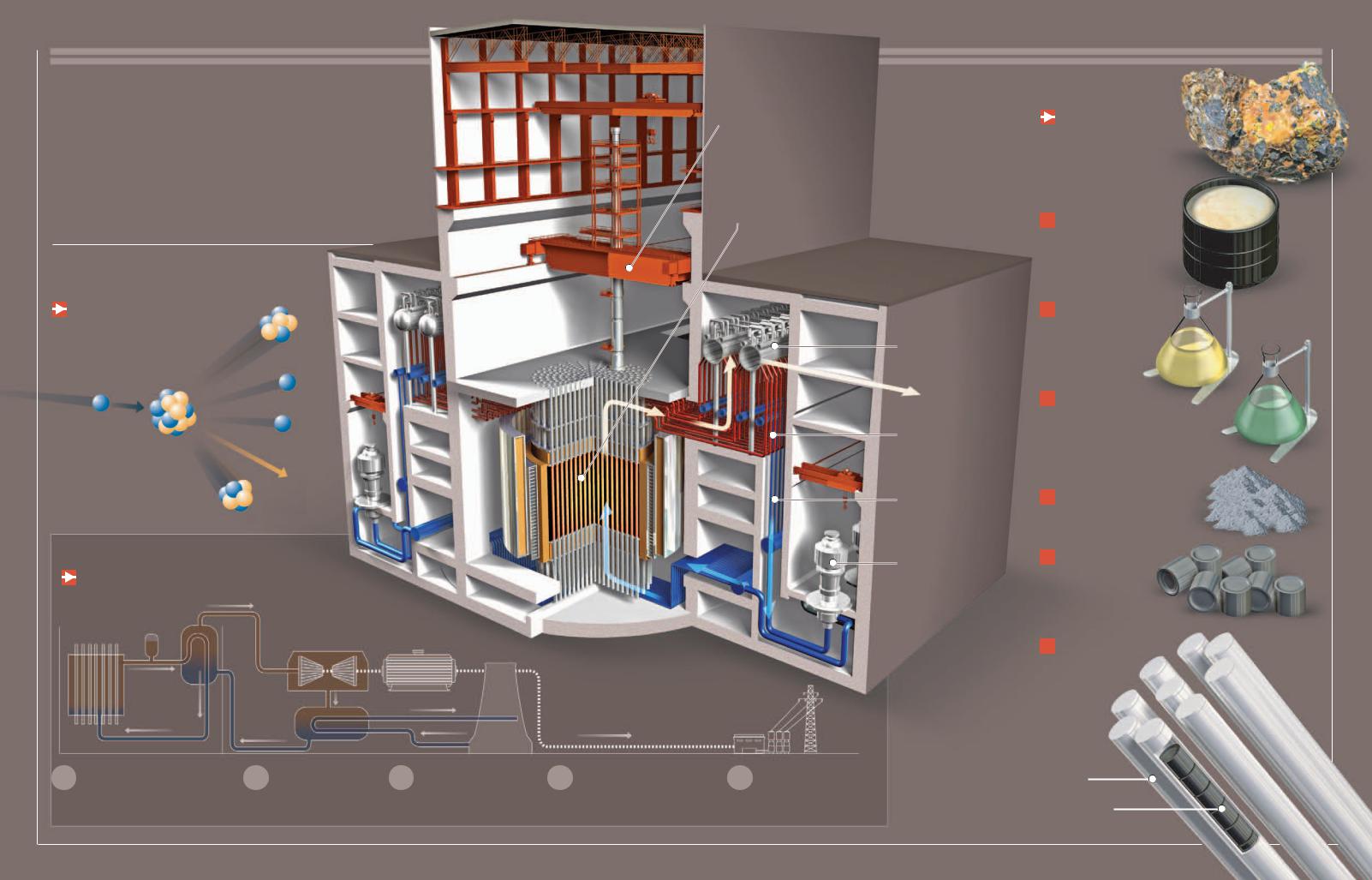
44 ENERGY RESOURCES
Nuclear Energy
Oobtaining electric energy is through a controlled nuclear reaction. Although this technology has beenne of the most efficient and cleanest methods for
used for half a century, it continues to be at the center of debate because of the risks it poses to the environment and health and because of the highly toxic waste it creates. 
Fission
The nuclei of certain atoms, like uranium-235, can be broken apart when
bombarded by neutrons. In doing so, they release great amounts of energy and new neutrons that can break down the nuclei of other atoms, generating a chain reaction.
Neutron
Moderator
To achieve the breakdown of the nucleus, the neutrons must collide with it at a specific speed, which is governed by a moderating substance, such as water, heavy water, graphite, and so on.
Neutron
Neutron
Nucleus of a uranium235 atom
Energy
Generation of Energy
The purpose of nuclear fission is to create very hot steam to operate turbines and electrical generators. The high temperatures
are achieved by using nuclear energy from the reactor.
|
Reactor |
|
|
|
|
|
|
|
|
|
|
Turbine |
Generator |
|
|
||
|
Exchanger |
|
|
|
|
|
|
|
|
|
|
|
|
Cooling |
|
|
|
|
|
|
|
|
tower |
|
|
|
1 |
Water |
2 |
Steam |
3 |
Electricity |
4 |
Recycling |
|
Pressurized water, together with the |
The resulting steam enters |
The steam enters the turbines |
The steam condenses |
|||||
|
|
|
|
|||||
|
moderator, is pumped through the core of |
|
an exchanger, where it heats |
|
and makes them run. The |
|
into liquid water and |
|
|
the reactor, and the temperature of the |
|
water until it too is |
|
turbines drive the generator that |
|
is reused. |
|
|
core increases by hundreds of degrees. |
|
converted into steam. |
|
produces electricity. |
|
|
|
 Mobile crane
Mobile crane
moves the mechanism that replenishes the reactor with nuclear fuel.
Reactor core
contains the radioactive fuel and is where the nuclear reaction takes place.
Transformer
5 Transport
Before transmitting electricity, a transformer increases its voltage.
370,000
Power, in megawatts (MW), generated by nuclear energy throughout the world
ENERGY AND MOVEMENT 45
Uranium
In nature, uranium appears associated with other minerals. In
addition, only 0.7 percent of uranium is the isotope uranium-235, necessary for nuclear fission. The proportion of uranium-235 must be increased 3 to 5 percent in a process called enrichment.
1The original mineral is treated until a substance called yellowcake is obtained that is 80 percent uranium.
Separators
separate the liquid water from the steam.
Steam to the turbines
Hot water pipes
Cold water pipes
Pump maintains the
circulation of the fluids in the system.
2During conversion, first uranium tetrafluoride (UF4) and then uranium hexafluoride (UF6) are obtained.
UF4
3The gaseous uranium hexafluoride is spun
repeatedly in a
centrifuge until it attains UF4 the desired concentration
of uranium-235.
4The enriched uranium gas is solidified again.
5Through compaction, pellets of enriched uranium are obtained that can be used as fuel in nuclear reactors.
6The pellets are put into hollow bars that are later placed in the core of the nuclear reactor.
436 |
Fuel rod |
|
|
|
|
|
|
||
The number of nuclear plants |
|
|
|
|
operating throughout the |
Uranium pellets |
|
|
|
world. More than 30 are in |
|
|
||
|
|
|
|
|
various stages of construction. |
|
|
|
|
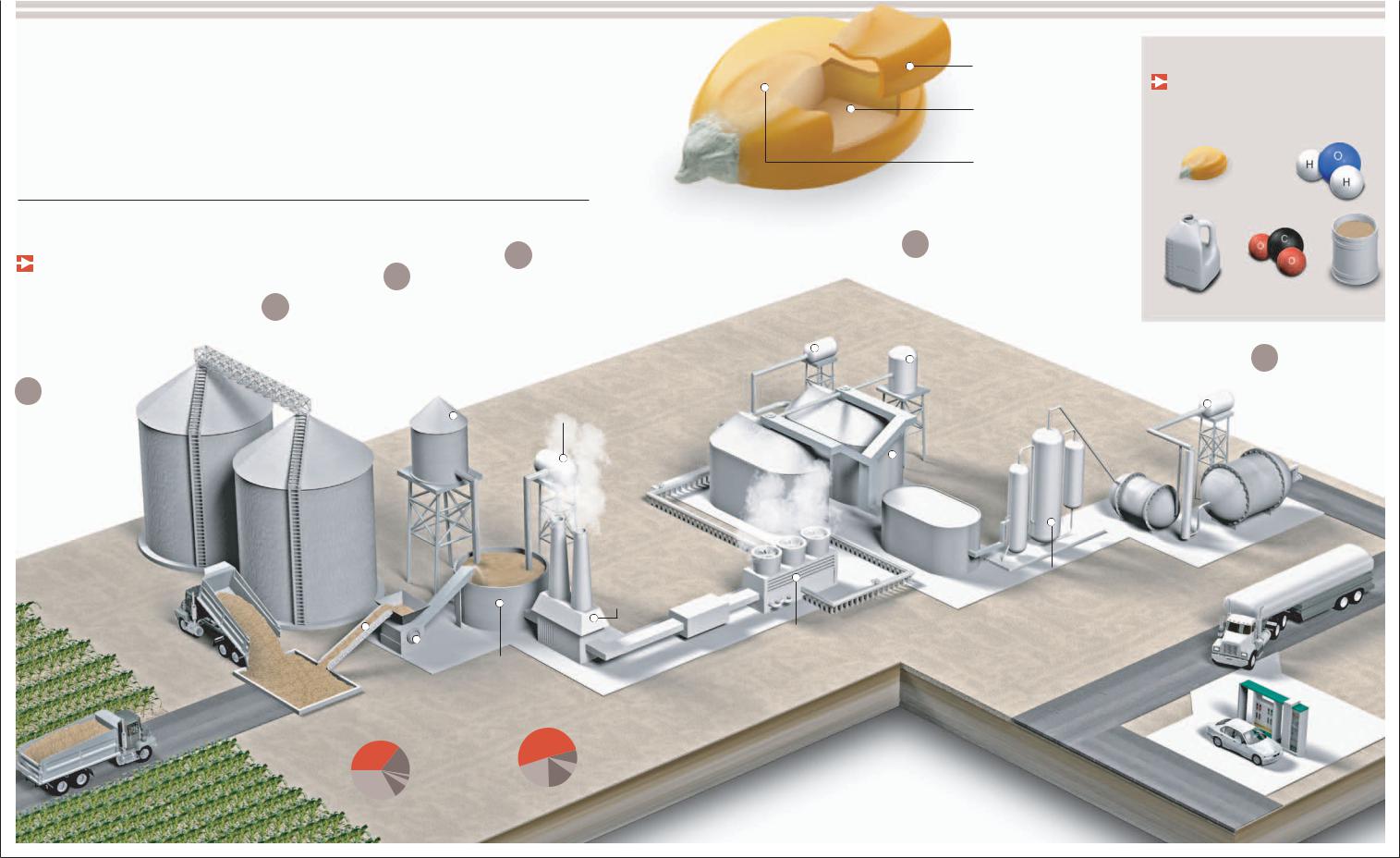
46 ENERGY RESOURCES
Biofuels
Gmore and more promising as solutions to the problems posed by the eventual exhaustion of the Earth's petroleum reserves, as well as the high cost of fossil fuels on the global market.asoline or diesel with added alcohol (ethanol) produced from crops such as corn appear
However, this type of energy presents new challenges. One item of environmental concern is the possibility that massive exploitation of biofuels could lead to the replacement of jungles and woodlands with single-crop plantations meant only for the production of raw plant materials. 
Ethanol
|
This is the alcohol in the medicine cabinets of |
|
|
|
4 |
||
|
our homes. It can be used in its pure form as a |
|
|
3 |
COOKING |
||
fuel or combined with gasoline in different |
|
|
The mixture is |
||||
proportions. The greater its purity, the greater are the |
|
|
|
||||
2 |
MILLING |
|
cooked at 300° F |
||||
engine modifications required to burn the fuel. Two |
|
||||||
|
(150° C) |
||||||
common mixtures are E10 and E85, which have 10 |
The raw material is |
|
|||||
|
(sterilization) and |
||||||
percent and 85 percent ethanol, respectively. |
|
|
|||||
|
milled, and the |
|
is finally cooled |
||||
|
|
|
|
||||
|
|
|
resulting flour is |
|
with a water- |
||
|
|
|
mixed with water. |
|
refrigeration |
||
|
|
|
Later an enzyme is |
|
system. |
||
|
|
|
added that helps |
|
|
|
|
1 |
HARVEST |
|
convert starch into |
|
|
|
|
|
sugar. |
|
|
|
|
||
Sugarcane, beets, |
|
|
|
|
|
||
|
|
|
|
|
|
|
|
|
corn, yucca, |
|
|
|
|
|
Water |
|
|
|
|
|
|
||
potatoes, and even wood can be used, with varying degrees of efficiency, to produce ethanol.
FERMENTATION
Yeast is added to convert sugar into ethanol. This process, which produces heat and carbon dioxide, lasts 60 hours. When finished, the mixture, called mash, is 15 percent ethanol.
Enzyme
Cooking
|
|
|
|
|
|
|
|
|
|
|
|
|
|
|
|
|
|
|
|
|
|
|
|
|
|
|
|
|
|
|
|
|
|
|
|
|
|
|
|
|
|
|
|
|
|
|
|
|
|
|
|
|
|
|
|
|
|
|
|
|
|
|
|
Cleaning |
|
|
|
|
|
|
|
|
|
|
|
Sterilization |
|
|
|
|||||||||||||
|
|
|
|
|
|
|
|
|
|
|
|
|
|
|
|
|
|
|
|
|
|
|||||||||
|
|
|
|
|
|
|
|
|
|
|
|
|
|
|
|
|
|
|
|
|
|
|
|
|
|
|
|
|
|
|
|
|
|
|
|
|
|
|
Milling |
|
|
|
|
|
|
|
|
|
|
|
|
||||||||||
Ethanol production (in 2006) |
Biodiesel production (in 2005) |
|||||||||||||||||||||||||||||
Germany |
|
|
U.S. |
|||||||||||||||||||||||||||
|
|
|
|
|
|
|
|
|
|
|
|
|
|
|
|
|
|
|
|
|
||||||||||
U.S. |
|
|
|
|
|
|
|
Others |
51% |
|
|
|
|
|
|
|
|
|
7.5% |
|||||||||||
36% |
|
|
|
|
|
|
|
|
16.5% |
|
|
|
|
|
|
|
|
|
|
|
|
|||||||||
|
|
|
|
|
|
|
|
|
|
|
|
|
|
|
|
|
|
|
|
|||||||||||
|
|
|
|
|
|
|
|
|
|
|
|
|
|
|
Russia |
Others |
|
|
Italy |
|||||||||||
Brazil |
|
|
|
|
|
|
|
20.7% |
|
|
|
|
|
|
|
|
6% |
|||||||||||||
|
|
|
|
|
|
|
|
|
|
|
|
|
|
|||||||||||||||||
33.3% |
|
|
|
|
|
|
|
|
|
|
|
|
|
1.2% |
France |
|
|
|
|
|
|
|||||||||
|
|
|
|
|
|
|
|
|
|
|
|
|
|
|
|
|
|
|
|
|||||||||||
|
|
|
|
|
|
|
|
|
|
|
|
|
|
|
France |
|
|
|
|
|
|
|||||||||
|
|
|
|
|
|
|
|
|
|
|
|
|
|
|
14.8% |
|
|
|
|
|
|
|
|
|
|
|||||
|
|
|
|
|
|
|
|
|
|
|
|
|
|
|
|
1.8% |
|
|
|
|
|
|
|
|
|
|
||||
|
|
|
|
|
|
|
|
|
|
|
|
|
|
|
|
|
|
|
|
|
|
|
|
|
|
|
||||
|
|
|
|
|
China |
|
|
|
|
|
|
|
|
|
|
India |
|
|
|
|
|
|
|
|
|
|
|
|
||
7.5% |
|
|
|
|
|
|
|
|
|
3.7% |
|
|
|
|
|
|
|
|
|
|
|
|
||||||||
|
|
|
|
|
|
|
|
|
|
|
|
|
|
|
|
|
|
|
|
|
||||||||||
|
|
|
|
|
|
|
|
|
|
|
|
|
|
|
|
|
|
|||||||||||||
KERNEL OF CORN
HULL
protects the seed from water, insects, and microorganisms.
ENDOSPERM
represents 70 percent of the weight of the dry grain. It contains starch, the substance used to produce ethanol.
GERM
The most valuable and the only living part of the grain. In addition to containing the genetic material, vitamins, and minerals, it is 25 percent oil.
5 DISTILLATION
The mixture is distilled first by evaporation to obtain 96 percent pure ethanol. It is later distilled by a molecular filtration process that can produce ethanol that is almost entirely pure. A 5 percent gasoline mixture is used for transportation.
ENERGY AND MOVEMENT 47
Byproducts
are generated during the production of ethanol. Anhydrous carbon is used in the manufacture of
soft drinks. The stillage, a very nutritious residue, is used to feed cattle.
55 pounds (25 kg) |
4 gallons (15 l) |
of corn |
+ of water |
PRODUCE
18.5 pounds |
18.5 pounds |
2.8 gallons |
+stillage(8.4 kg) of |
(10.5 l) of ethanol +carbon(8.4 kg)dioxideof |
Yeast |
|
|
|
|
|
6 |
USE |
|||
|
|
|||||||||
|
|
|
|
|
|
Carbon dioxide |
|
|||
|
|
|
|
|
|
|
Ethanol is added to |
|||
|
|
|
|
|
|
|
||||
|
|
|
|
|
|
collection |
|
|
|
|
|
|
|
|
|
|
|
|
|
|
gasolines in different |
|
|
|
|
|
|
|
|
|
|
proportions to be used in |
|
|
|
|
|
|
|
Gasoline |
|
|
vehicles. Gasolines with |
|
|
|
|
|
|
|
|
|
ethanol content between |
|
|
|
|
|
|
|
|
|
|
|
|
|
|
|
|
|
|
|
|
|
|
10 and 30 percent do not |
|
|
|
|
|
|
|
|
|
|
require vehicle engines to |
|
|
|
|
|
|
|
|
|
|
have special |
|
|
|
|
|
|
Fermentation |
|
|
|
modifications. |
|
|
|
|
|
|
|
|
|
||
|
|
|
|
|
|
tanks |
|
|
|
|
Distillation
Refrigeration
70%
of the world's ethanol production is accounted for by Brazil and the United States. In Brazil, ethanol is made from sugarcane, and in the United States, it is made from corn.
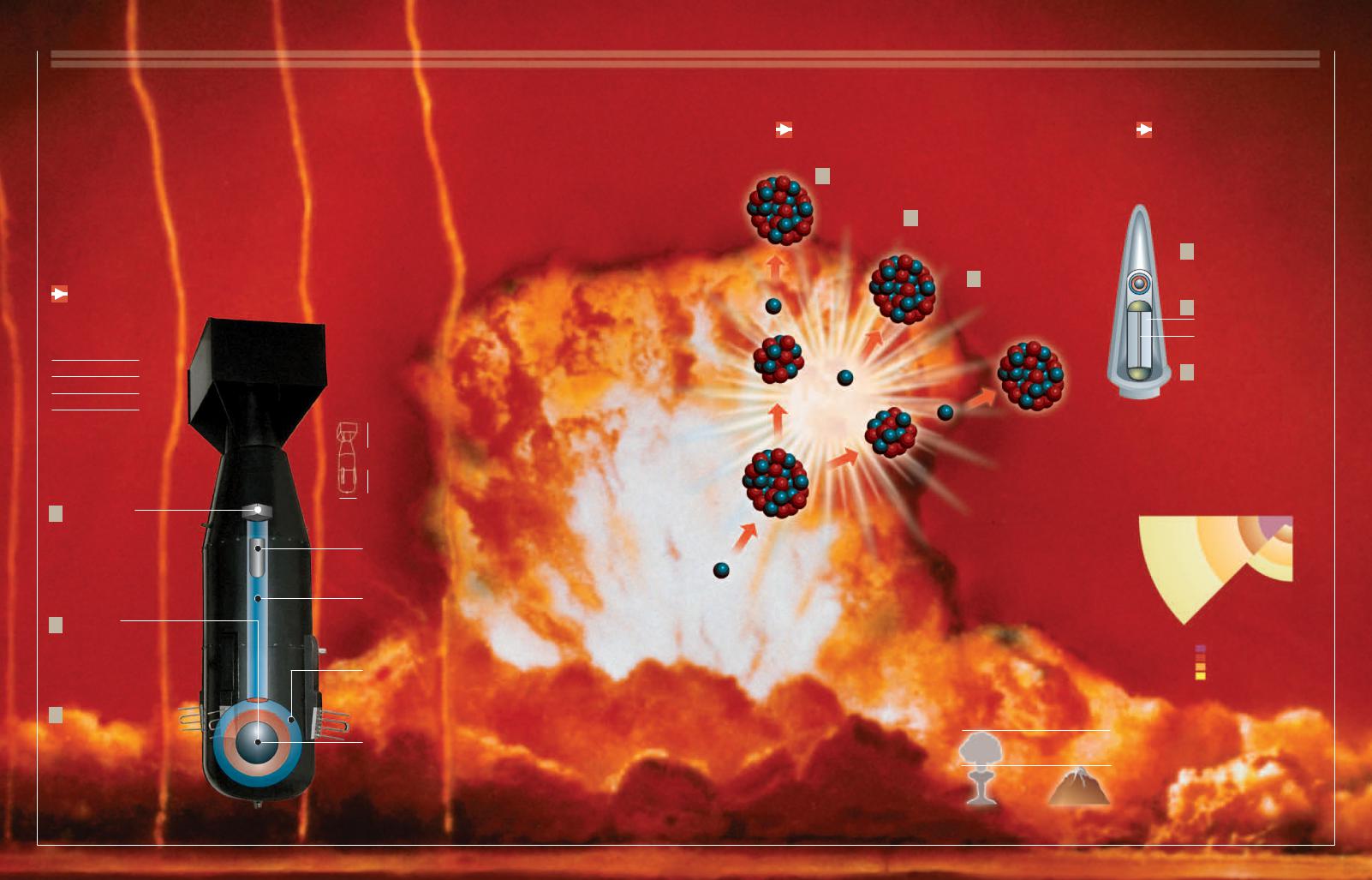
60 ENERGY RESOURCES
Fission and Chain Reaction
Tfirst time against Japan, marking the end of World War II and the destruction of the cities of Hiroshima and Nagasaki. In addition to the massive loss of human life at the moment ofhis weapon of mass destruction derives its energy from nuclear reactions. It was used for the
detonation, many cases of cancer and genetic repercussions followed in the adjacent areas affected by radioactivity. Apparently the horror of witnessing what an atomic bomb could do was not enough, as today many countries have atomic arsenals even more powerful than the bombs used in 1945. 
The Hiroshima Bomb
It exploded on August 6, 1945, at a height of 1,870 feet (570 m) over the
downtown of this Japanese city, taking more than 70,000 lives. It was a fission bomb.
Name |
Little Boy |
Type |
Fission |
Power |
14.5 kilotons |
Weight |
4.4 tons |
1 DETONATION
An altimeter determines the appropriate height for the explosion and detonates a charge of common explosives; this process impels the projectile toward the atomic explosive.
2 REACTION
The projectile travels through the gun tube and impacts the uranium-235 contained inside the generator. This is what initiates the nuclear chain reaction.
3 EXPLOSION
The chain reaction occurs in a fraction of a second, releasing enormous amounts of energy as heat and lethal radiation.
10.5 feet
(3.2 m)
2.4 feet
(0.74 m)
WARHEAD
Made of uranium-235, it is highly fissile.
GUN TUBE
COMPRESSOR concentrates the chain reaction so that the greatest amount of atomic explosive can undergo fission before the explosion.
ATOMIC EXPLOSIVE
Compact sphere of uranium-235. Its power equals 14,500 tons of TNT (trinitrotoluene).
ENERGY AND MOVEMENT 61
Fission and Chain Reaction
Nuclear fission divides the nucleus of the uranium atom by bombarding it with neutrons.
A neutron strikes
1the nucleus of a uranium-235 atom.
The nucleus splits in two,
2releasing three neutrons and an enormous amount of energy.
The three neutrons that were 3 released collide with other
uranium-235 nuclei, which then divide and release more neutrons and energy. The chain reaction is sustained in this way until the uranium is depleted.
The Fusion Bomb
Even more powerful atomic bombs use a different type of nuclear reaction—the
fusion of hydrogen. That is why they are also known as hydrogen bombs. They have a power of up to 9,000 kilotons.
DETONATION
1A small atomic fission bomb explodes, generating large amounts of heat inside the container.
REACTION
2 The heat compresses the deuterium (hydrogen isotope) against the rod of plutonium, causing fusion.
EXPLOSION
3The fusion of deuterium takes place in a fraction of a second, causing the explosion.
NUCLEAR ARSENALS
During the Cold War in the second half of the 20th century, the United States and the Soviet Union built large arsenals of nuclear weapons. In addition, several other countries developed nuclear-weapon capabilities. Today it is believed that the United States and Russia (which maintained control of the former Soviet Union's weapons) each have more than 5,000 deployed nuclear warheads with perhaps as many in storage. France, Britain, and China are each estimated to have more than 100 nuclear weapons. India and Pakistan have publicly tested nuclear weapons and may have more than a dozen each.
THE ATOMIC MUSHROOM CLOUD is formed by the shock wave, which absorbs the dust of everything that was burned.
46,000 feet (14,000 m)
29,029 feet (8,848 m)
Mushroom cloud |
Mount Everest |
of Hiroshima |
|
DAMAGE SCALE
Comparison between two nuclear explosions of differing power
7 MILES |
4.6 MILES |
2.7 MILES |
1.7 MILES |
(12 KM) |
(7.5 KM) |
(4.3 KM) |
(2.7 KM) |
0.5 MILE
(0.8 KM)
1.3 MILES
FUSION BOMB (2.1 KM)
1,000 KILOTONS
2.4 MILES
(3.9 KM)
3.2 MILES
(5.1 KM)
HIROSHIMA
14.5 KILOTONS
TOTAL VAPORIZATION
TOTAL DESTRUCTION
SEVERE DAMAGE
SEVERE FIRES
